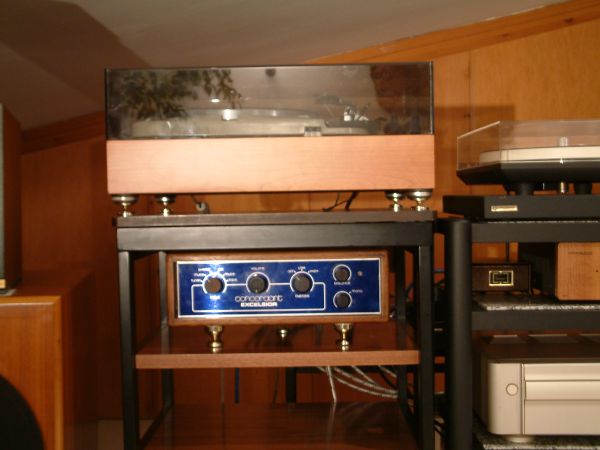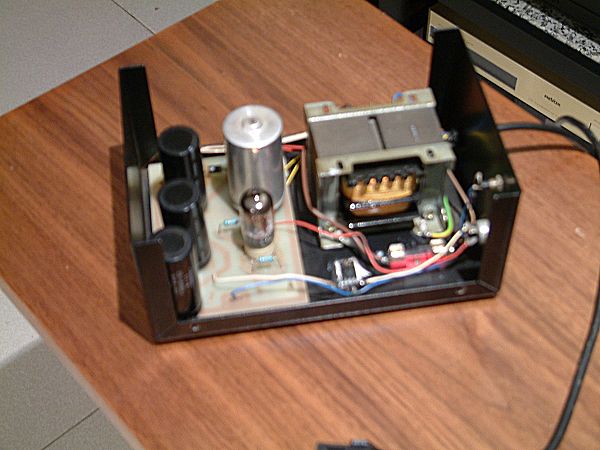
| [ Concordant Excelsior: A Preamp To Re-Discover ] |
© Eduard de Cáceres. 2003
Some days ago I replaced my reference preamplifier – a new tube model – with a long desired Concordant Excelsior. Maybe this make will not ring a bell and very few will place it among the reference preamplifiers. A part from some brief comments in the net and a couple of reviews (Hi-Fi World 12/1991) and Scherzo (n.142 – 12/2000) very little more can be found about those components. Not enough for such an exquisite implementation.
My fist experience with a Concordant Excelsior data back in 1989, when I was a student in London. The preamp and its sound draw my attention immediately, but 879 GBP for a preamp where just out of my budget – mi “integrated” was a modest grey Cambridge P70 -. Apparently Concordant Audio started its production in 1984 (near the massive digital audio boom) and disappear from the common British audio pricelists in 1993/1994, with a price then of 1.500 GBP.

The Concordant is one of the excellences of British audio, that belongs to the “Twilight Era” of the best tube audio, that is between the lasts Seventies and mid Eighties. Makes like Audio Innovations, Michaelson & Austin, the handmade products by the Mellotone Acoustic Co, etc...
I was lucky to buy one of the units in London in 1997 (second hand) for a fried of mine, who is still proud and happy with the Excelsior. Since then I had thought there would not be a chance for me to find one for me, as the are rare as hen’s teeth.In a recent visit to London, in July 2003 I was able to have a look a t one laying in the of Walrus City, for most a cult hi-fi shop. I started to dream again. Back in Barcelona I looked up in the net, and luckily found one at the Emporium. My decision was immediate.
The unit arrived as expected, on time, well packed, but no instructions at all. Doug Dunlop, its designer, apparently gave his private phone number and four year guarantee as the sole explanations.Connected to my equipment, the Excelsior show some problems and was immediately sent to repair. A 5695 tube in the Power Supply was in bad shape and it looked like some one did a bad job in it.The rest of the tubes (originals) ECC83 Golden Dragon and 6CGT (GE NOS) worked perfectly.

The Alps volume control has been replaced with a DACT and some of its components have been replaced by new ones. No “improvement” but update.

The volume control is at the end of the circuit (passive preamp?) so the upgrade to a better mechanism remains an upgrade up to the owner or potential buyer.Despite of the not too good quality of some of the components (RCA connectors, ..) I decided no to do further changes to my Excelsior.By the way: the Excelsior now sits on three nice Perfect Sound spikes: it’s original (?) wooden feet were on bad shape.
It is difficult nowadays for me to justify the position o a preamplifier in any modern system based in line-level sources. My equipment being an exception, with two analogue sources and still waiting to add a third one; anyway I still consider that very few preamps are worth being used. No doubt the Excelsior is one of those few, and I refer to preamps at any level.
For the testing I have used Thorens TD124 Mk1 + Shure V15xmr and tube pre-pre PM-1 by Consonance, a second analogue source, a modern Rega P9 + Ortofon MC30 Supreme, linked via Bartolucci MC step-uo transformer to the Excelsior own phono input. As digital sources SACD 1000 by Philips and CD15 by Marantz were used. The power amp is a cherished Michaelson & Austin TVA-1 and Monitor Sequerra Met-7 MkII + Super ribbon tweeter Met-9 MkII and a bass extension tailor made by Marià Moya, (replacing Sequerra’s original Met-8 ). Needs to mention that the Sequerra System has recently been updated with new original tweeters and ribbons sent by Dick’s (4/2003) and carefully been fixed and adjusted by Marià: the combo’s sound is no less than remarkable for its dynamics, detail, image and low sound deformation and fidelity.

The preamp is neutral both in tone and timbre. Each and every component tends to colour somehow a system, but the Excelsior’s presence is hardly noticed when one listened to acoustic music with no use of electronic amplification, always having in mind the sound of the “live” instrument. For that purpose the listening to LP by DECCA (SXL 6545 – 1972) Alicia de Larrocha Plays J.S. Bach: Concerto In Italian Style n.6 ; also HÄNDEL, Concerto pour Harpe et Orch. En si b mayor, Lily Laskine soloist accompanied by Orch. De Chambre de Toulouse I the unequaled version of “Les Discophiles Français” and the Cancionero de Palacio of Jordi Savall (CD-Astrée).
The voices appear well in position, clear and defined. Even in front of remarkable effort as in Carlo Bergonzi’s, Opreatic Recital (London DECCA 240 re-edition vinyl 180g). Diana Krall (CD Impulse: Love Scenes) sounded like the angles, Rebecca Pidgeon in Chesky’s reference The Raven looked like she wanted to give us her hand from the scene for its image was so real and quasi-holographic, Roma Ryan, engineered by the means of her partner made me fly in subtle vapours in “Orinoco Flow” from LP Watermark (WEA) – not in vain one of Harry Pearson’s references-, Cassandra Wilson’s voice was recognisable and touchable and deep in Traveling Miles (CD Blue Note); Jacintha with a velvety voice in Autumn Leaves version SACD by Groove Note, a recording which surprises for the reality that this format is capable of; Kiri Te Kanawa imposes its soprano’s power over jazz instruments in a limited space and exceeds in Kiri Sidetracks – The Jazz Album (version CD by Philips).
My listening room has always been prone to re-create a deep image and scene. Big but not exagerated, and I have always been found of this acoustic effect. The Excelsior has added focus, horizontality , but with no excessively accurate detail – as in other preamps, mainly modern transistor ones-.
The Excelsior did well with all the tests in a long listening session (dynamics: Bruckner, 4º Sinfonía – Wiener Phil. Dir. Karl Böhm CD/DECCA ), image (Itzhak Perlman/Royal Phil. Orch. – Lawrence Foster: Paganini Violin concerto N. 1/Pablo de Sarasate ... version CD/EMI). I remark the restitution obtained of this last recording so much used by some audiophiles in my country. Ramón Ribó made me aware of the soloist image, a real hard trick for many equipment and speakers in particular. The system commanded by the Excelsior made me forgot the detail, as its capability to re-create the “maestoso” (track N.1) never was so well reproduced.There is air in the scene, and I forget to try and place the violin which hardly moves, I forget all the tricks and hints and I simply listen to music.Somehow audiophile’s sin is always to try and look for the detail and the defect... at last with my equipment I’ve managed to listen to music after many years of changes.
My recommendation to audiohiles is to search in the net becasuse there is where it is possible to find this escellent machines. maybe it could be a hard work but the result obteined deserves it.
First of all my congratulations to Scherzo and to the Mr. Balsa. Scherzo is one of those few journals where I have read interesting articles but in this article I have found some mistakes that maybe can be of important for audiofiles interested in technical questions.
The 6CG7/6FQ7 tube doesn't acts as a rectifier, in fact it downs the impedance of the phono section. In the power supply unit a 5965 downs the voltage from 350 V to 250 V. For rectification the circuit uses two diodes for the high voltage, voltage doubler and an encapsulated stabilizer. A final advice: Set the voltage selector to 220V if used in mainland Europe, insted of the 240v setted at the factory for use in UK. The result will be less stress for the tubes. Also try to find some 5965 tubes as spares.
Sadly I have been capable to read in some forum in the net about the trespass of Concordant Excelsior’s designer and factotum Doug Dunlop Esq. This review be in memoriam of one of the genious of hand crafted audio, often not well known as they truly deserve.
September 21st, 2005. Due to an article about the Concordant Excelsior recently published by TNT Audio, Eduard de Cáceres has asked to me to ad this comment to his text after talking with Mark Wheeler the author of TNT Audio article on the Concordant Excelsior:
About the question of the use of the 6CG7 and 5965 tubes in the Excelsior that seems confuse. My expert technician, the one who fully serviced the preamp found that the 5965 is in the power supply and the 6CG7 in the preamp/phono section. We haven't found the schematics for the preamp but we have talked to Mark Wheeler (author of the Excelsior article published by TNT Audio) about this matter. It seems that my preamp is one of the last versions made by Doug Dunlop who always was trying to modify something in his desings to improve them (it originally used Golden Dragon tubes). In theory the description that Mark gives about the circuit of the Excelsior is more coherent, but my unit is working perfectly and also has a logical design with the tubes in the position described in the article. Everybody with doubts about this preamp can contact me for further discussion about this matter.